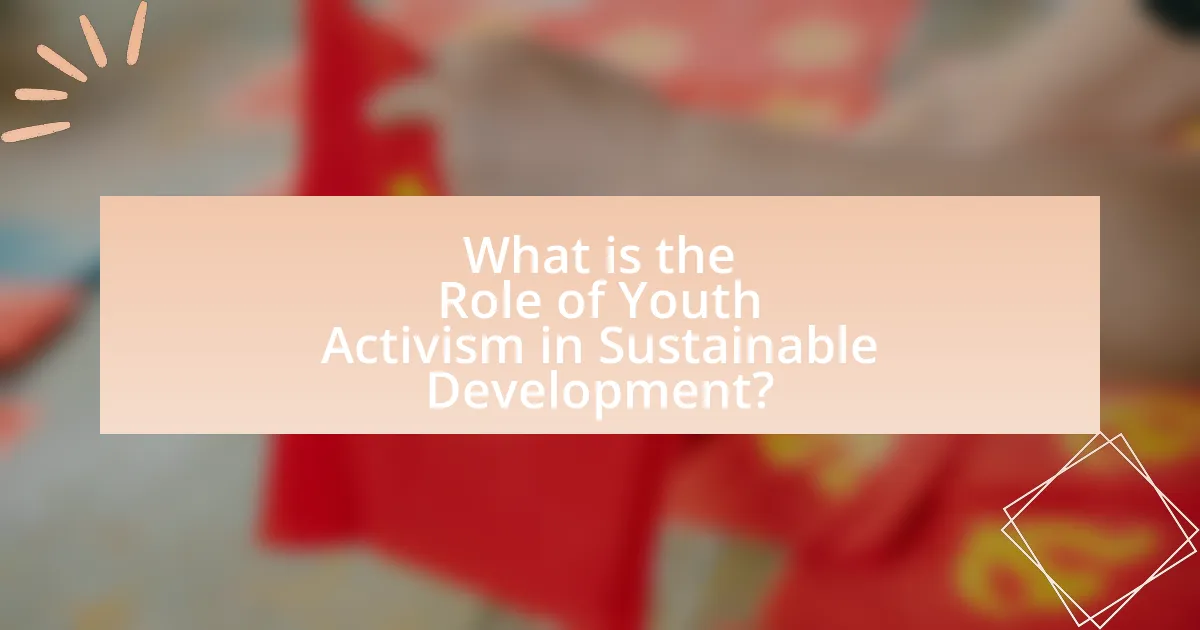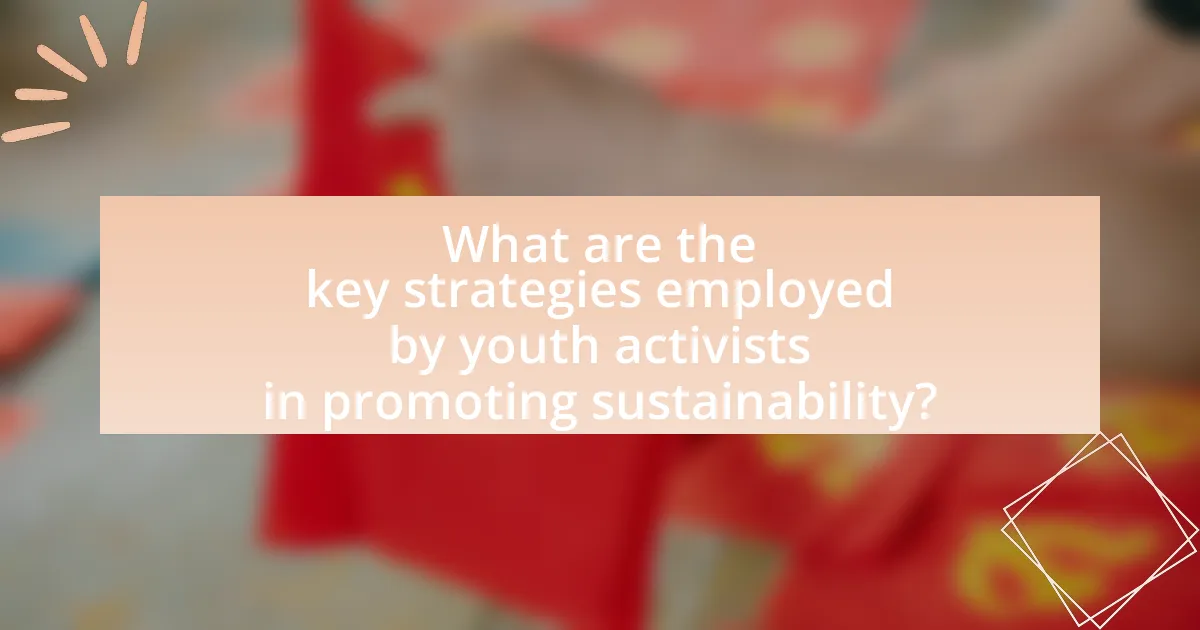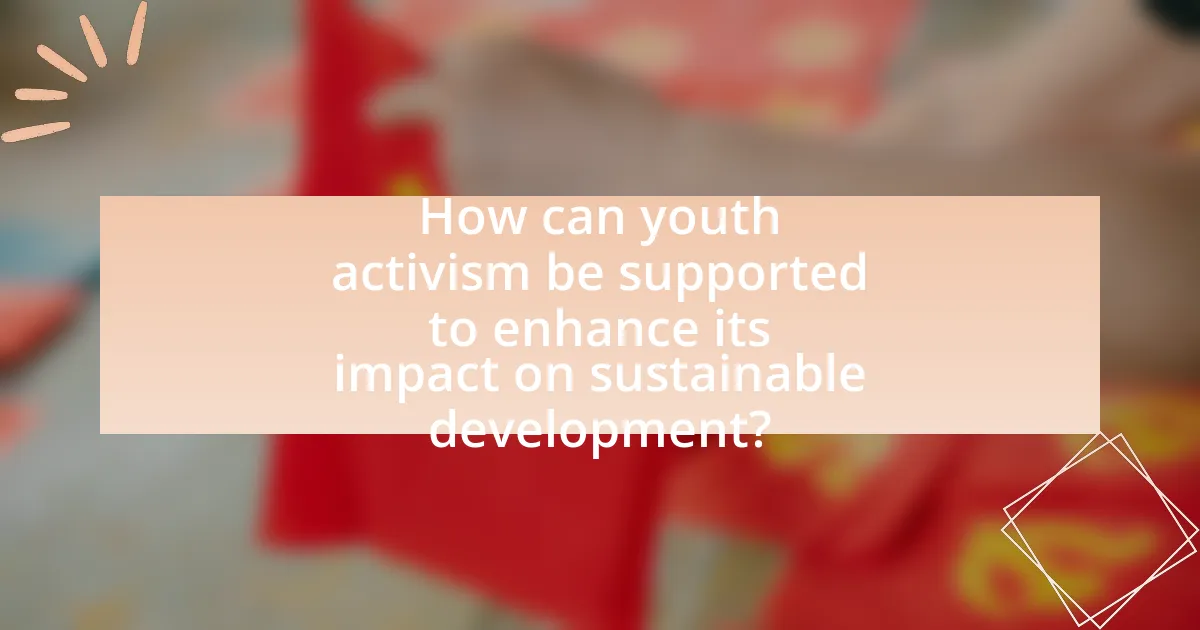Youth activism is a pivotal force in advancing sustainable development by advocating for social, environmental, and economic justice. This article explores the significant contributions of young activists to the United Nations’ Sustainable Development Goals (SDGs), particularly in areas such as climate action, quality education, and peace. It highlights the strategies employed by youth, including grassroots organizing and digital advocacy, and examines the challenges they face, such as funding limitations and political barriers. Additionally, the article discusses the role of educational institutions and mentorship in empowering youth, as well as successful examples of youth-led initiatives that have made measurable impacts on sustainability.

What is the Role of Youth Activism in Sustainable Development?
Youth activism plays a crucial role in sustainable development by driving social change and influencing policy decisions. Young activists often raise awareness about environmental issues, advocate for climate action, and promote sustainable practices within their communities. For instance, movements like Fridays for Future, initiated by Greta Thunberg, have mobilized millions of young people globally to demand urgent action on climate change, highlighting the importance of youth voices in shaping a sustainable future. Research indicates that youth-led initiatives can lead to significant policy shifts, as seen in the adoption of the Paris Agreement, where youth advocacy was instrumental in pushing for stronger commitments to reduce carbon emissions.
How does youth activism contribute to sustainable development goals?
Youth activism significantly contributes to sustainable development goals by mobilizing young people to advocate for social, environmental, and economic justice. This activism raises awareness about issues such as climate change, inequality, and education, directly aligning with the United Nations’ Sustainable Development Goals (SDGs). For instance, the Global Climate Strike, initiated by youth activist Greta Thunberg, has galvanized millions worldwide to demand urgent action on climate change, thereby promoting SDG 13 (Climate Action). Furthermore, youth-led organizations often engage in community projects that address local needs, fostering sustainable practices and enhancing community resilience, which supports multiple SDGs, including SDG 11 (Sustainable Cities and Communities) and SDG 4 (Quality Education). Through their advocacy and grassroots initiatives, young activists play a crucial role in driving progress towards achieving these global goals.
What specific sustainable development goals are influenced by youth activism?
Youth activism significantly influences several specific Sustainable Development Goals (SDGs), particularly Goal 4 (Quality Education), Goal 13 (Climate Action), and Goal 16 (Peace, Justice, and Strong Institutions). Youth-led movements advocate for equitable access to education, emphasizing the importance of quality learning environments and inclusive educational policies. For instance, the Global Youth Climate Network mobilizes young people to demand urgent climate action, directly impacting Goal 13 by raising awareness and pushing for policy changes. Additionally, youth activism promotes transparency and accountability in governance, aligning with Goal 16 by encouraging participation in democratic processes and advocating for justice and peace initiatives.
How do youth-led initiatives align with global sustainability efforts?
Youth-led initiatives align with global sustainability efforts by actively promoting environmental awareness, social equity, and economic viability. These initiatives often focus on addressing climate change, advocating for renewable energy, and pushing for sustainable practices within communities. For instance, the Global Youth Climate Network mobilizes young people to engage in climate action, influencing policies that support sustainable development goals (SDGs). Furthermore, research from the United Nations indicates that youth involvement is crucial for achieving SDG 13 (Climate Action), as their innovative approaches and grassroots movements drive significant change.
Why is youth activism important in the context of sustainability?
Youth activism is crucial in the context of sustainability because it drives innovative solutions and mobilizes collective action towards environmental issues. Young activists, such as those involved in movements like Fridays for Future, have successfully raised global awareness about climate change, influencing policy decisions and encouraging sustainable practices. For instance, a 2019 study published in the journal “Nature” highlighted that youth-led protests significantly increased public discourse on climate policies, demonstrating their impact on societal attitudes and governmental responses. This engagement not only empowers young individuals but also ensures that sustainability efforts reflect the values and needs of future generations.
What unique perspectives do young activists bring to sustainability discussions?
Young activists bring fresh, innovative perspectives to sustainability discussions by emphasizing urgency, inclusivity, and intersectionality. Their focus on immediate action reflects a deep concern for the future, as evidenced by movements like Fridays for Future, which mobilized millions globally to demand climate action. Additionally, young activists advocate for the inclusion of diverse voices, recognizing that marginalized communities often bear the brunt of environmental degradation. This approach aligns with findings from the United Nations Environment Programme, which highlights the importance of youth engagement in achieving sustainable development goals. Furthermore, their understanding of digital platforms allows them to effectively communicate and mobilize support, making sustainability a more accessible and relatable issue for their peers.
How does youth activism drive innovation in sustainable practices?
Youth activism drives innovation in sustainable practices by mobilizing young people to advocate for environmental change and challenge existing systems. This demographic often leverages social media to raise awareness, organize campaigns, and influence policy, leading to the adoption of new technologies and practices that prioritize sustainability. For instance, movements like Fridays for Future have successfully pressured governments to commit to carbon neutrality, demonstrating the tangible impact of youth-led initiatives on legislative frameworks. Additionally, youth activists often collaborate with startups and organizations focused on green technology, fostering an environment where innovative solutions can emerge and gain traction.

What are the key strategies employed by youth activists in promoting sustainability?
Youth activists employ several key strategies to promote sustainability, including grassroots organizing, digital advocacy, and educational outreach. Grassroots organizing involves mobilizing local communities to participate in sustainability initiatives, such as clean-up drives and tree planting events, which fosters community engagement and collective action. Digital advocacy leverages social media platforms to raise awareness, share information, and mobilize support for sustainability campaigns, exemplified by movements like Fridays for Future, which gained global traction through online engagement. Educational outreach focuses on informing peers and the broader public about sustainability issues, often through workshops, seminars, and school programs, thereby empowering individuals to adopt sustainable practices. These strategies are effective as they create a multi-faceted approach to sustainability that combines local action with global awareness.
How do youth activists mobilize communities for sustainable change?
Youth activists mobilize communities for sustainable change by leveraging social media, grassroots organizing, and educational initiatives. They utilize platforms like Instagram and Twitter to raise awareness about environmental issues, engage peers, and disseminate information rapidly. For instance, the global climate strikes initiated by youth activists in 2019, led by figures like Greta Thunberg, demonstrated the power of social media in rallying millions worldwide to advocate for climate action. Additionally, youth activists often organize local events, workshops, and community meetings to foster dialogue and collaboration among community members, thereby building a collective vision for sustainability. Research from the United Nations indicates that youth-led initiatives can significantly enhance community engagement and drive policy changes, highlighting the effectiveness of their mobilization efforts.
What role does social media play in youth activism for sustainability?
Social media serves as a crucial platform for youth activism in sustainability by facilitating communication, mobilization, and awareness-raising. It enables young activists to share information rapidly, organize events, and connect with like-minded individuals globally. For instance, movements like Fridays for Future, initiated by Greta Thunberg, gained momentum through social media channels, reaching millions and inspiring climate strikes worldwide. Research indicates that 70% of young people believe social media is essential for raising awareness about environmental issues, highlighting its effectiveness in engaging youth in sustainability efforts.
How do grassroots movements initiated by youth impact local sustainability efforts?
Grassroots movements initiated by youth significantly enhance local sustainability efforts by mobilizing community engagement and fostering innovative solutions. These movements often raise awareness about environmental issues, leading to increased participation in sustainability initiatives such as recycling programs, community gardens, and renewable energy projects. For instance, the Sunrise Movement in the United States has successfully advocated for the Green New Deal, which emphasizes sustainable practices and climate justice, demonstrating the power of youth-led activism in shaping local policies. Additionally, research from the Global Youth Climate Network indicates that youth-led initiatives can lead to a 30% increase in community involvement in sustainability practices, showcasing their effectiveness in driving local change.
What challenges do youth activists face in their sustainability efforts?
Youth activists face significant challenges in their sustainability efforts, primarily including lack of funding, limited access to decision-making platforms, and generational divides in understanding environmental issues. Funding constraints hinder their ability to implement projects and campaigns effectively, as many rely on grants or donations that are often scarce. Limited access to decision-making platforms restricts their influence on policies that affect sustainability, as established institutions may overlook or undervalue youth perspectives. Additionally, generational divides can create communication barriers, making it difficult for youth to engage older stakeholders who may not prioritize or understand the urgency of sustainability issues. These challenges collectively impede the effectiveness of youth activism in driving sustainable development initiatives.
How do political and social barriers affect youth-led sustainability initiatives?
Political and social barriers significantly hinder youth-led sustainability initiatives by limiting access to resources, decision-making processes, and public support. For instance, restrictive policies can prevent young activists from engaging with governmental bodies or securing funding for their projects, as seen in various countries where youth movements face legal challenges. Additionally, social barriers such as ageism and lack of recognition can undermine the credibility of youth-led efforts, making it difficult for these initiatives to gain traction within communities. Research indicates that youth-led organizations often struggle to influence policy due to these barriers, which can stifle innovation and reduce the overall impact of their sustainability efforts.
What resources are necessary for youth activists to overcome these challenges?
Youth activists require access to education, funding, mentorship, and technology to effectively overcome challenges in their activism. Education equips them with knowledge about sustainable development issues and advocacy strategies, while funding provides the necessary financial support for projects and initiatives. Mentorship from experienced activists or organizations offers guidance and networking opportunities, enhancing their impact. Additionally, technology facilitates communication, organization, and outreach, allowing youth activists to mobilize support and share their messages widely. These resources collectively empower youth to address and navigate the complexities of sustainable development challenges effectively.

How can youth activism be supported to enhance its impact on sustainable development?
Youth activism can be supported to enhance its impact on sustainable development by providing access to education, resources, and platforms for engagement. Educational programs that focus on sustainability and civic engagement empower young activists with knowledge and skills necessary for effective advocacy. For instance, initiatives like the United Nations’ Youth 2030 Strategy aim to equip youth with tools to influence policy and drive change. Additionally, funding and mentorship opportunities can help youth-led organizations scale their efforts, as evidenced by the success of programs like the Global Youth Mobilization, which has supported over 1,000 youth-led projects worldwide. Furthermore, creating inclusive spaces for dialogue between youth and decision-makers fosters collaboration and amplifies youth voices in sustainability discussions.
What role do educational institutions play in fostering youth activism for sustainability?
Educational institutions play a crucial role in fostering youth activism for sustainability by providing knowledge, resources, and platforms for engagement. They educate students about environmental issues, sustainability practices, and the importance of civic participation, which empowers youth to advocate for change. For instance, programs that integrate sustainability into the curriculum, such as project-based learning and community service initiatives, have been shown to increase student involvement in environmental activism. Research from the National Education Association indicates that students who participate in sustainability-focused projects are more likely to engage in activism and community organizing, demonstrating the effectiveness of educational institutions in nurturing a generation of informed and active citizens.
How can mentorship programs empower young activists in sustainability?
Mentorship programs empower young activists in sustainability by providing guidance, resources, and networking opportunities that enhance their effectiveness. These programs connect inexperienced activists with seasoned professionals who can share knowledge about sustainable practices, advocacy strategies, and policy-making processes. For instance, a study by the International Institute for Environment and Development found that mentorship significantly increases the confidence and skills of young activists, leading to more impactful initiatives. Additionally, mentorship fosters collaboration, enabling young activists to build relationships with other stakeholders in the sustainability sector, which can amplify their voices and initiatives.
What partnerships can enhance the effectiveness of youth-led sustainability initiatives?
Collaborations with local governments, non-profit organizations, and educational institutions can significantly enhance the effectiveness of youth-led sustainability initiatives. Local governments can provide resources, policy support, and platforms for youth to engage in decision-making processes, as evidenced by programs like the Youth Council in various cities that empower young people to influence local environmental policies. Non-profit organizations can offer mentorship, funding, and networking opportunities, which have been shown to amplify the impact of youth initiatives, such as the partnership between the Global Youth Climate Network and local youth groups that led to successful climate action campaigns. Educational institutions can facilitate research, provide training, and foster innovation through partnerships that encourage students to develop sustainable solutions, as seen in university-led sustainability projects that involve student participation. These partnerships create a collaborative ecosystem that strengthens the capacity and reach of youth-led initiatives in sustainability.
What are some successful examples of youth activism in sustainable development?
Successful examples of youth activism in sustainable development include the Fridays for Future movement, initiated by Greta Thunberg, which mobilized millions of students worldwide to demand action on climate change. This movement has led to significant policy discussions and commitments from various governments to reduce carbon emissions. Another example is the Sunrise Movement in the United States, which advocates for a Green New Deal and has successfully influenced political candidates to prioritize climate action in their platforms. Additionally, the Global Youth Climate Network has engaged young people in various countries to participate in climate negotiations, resulting in increased youth representation in international forums like the United Nations Climate Change Conferences. These examples demonstrate the impactful role of youth in driving sustainable development initiatives.
How have specific youth-led projects made a measurable impact on sustainability?
Specific youth-led projects have made a measurable impact on sustainability by implementing initiatives that reduce carbon footprints and promote environmental awareness. For example, the “Fridays for Future” movement, initiated by Greta Thunberg, has mobilized millions of young people globally to advocate for climate action, resulting in increased governmental commitments to reduce greenhouse gas emissions. Additionally, projects like “Youth Climate Leaders” have trained over 1,000 young activists in various countries, equipping them with skills to lead local sustainability initiatives, which have led to the implementation of community-based recycling programs and renewable energy projects. These efforts have been documented to contribute to a measurable decrease in waste and an increase in renewable energy adoption in participating communities.
What lessons can be learned from successful youth activism campaigns?
Successful youth activism campaigns demonstrate the importance of grassroots organization, effective communication, and leveraging social media for mobilization. Grassroots organization allows youth to build strong community ties and create a collective identity, which was evident in campaigns like the March for Our Lives, where students united to advocate for gun control after the Parkland shooting. Effective communication ensures that messages resonate with diverse audiences; for instance, the climate strikes led by Greta Thunberg effectively conveyed urgency and mobilized millions globally. Additionally, social media serves as a powerful tool for outreach and engagement, as seen in the #FridaysForFuture movement, which utilized platforms to spread awareness and coordinate actions. These elements collectively highlight that successful youth activism relies on community engagement, clear messaging, and digital strategies to amplify their voices and drive change.
What practical steps can young people take to engage in sustainable activism?
Young people can engage in sustainable activism by participating in community initiatives focused on environmental conservation, such as tree planting and clean-up drives. These activities not only promote ecological health but also foster community engagement and awareness. Research indicates that youth-led environmental movements, like the Fridays for Future campaign initiated by Greta Thunberg, have significantly raised global awareness about climate change, demonstrating the impact of collective youth action. Additionally, young individuals can advocate for policy changes by joining or forming organizations that lobby for sustainable practices, thereby influencing local and national legislation.